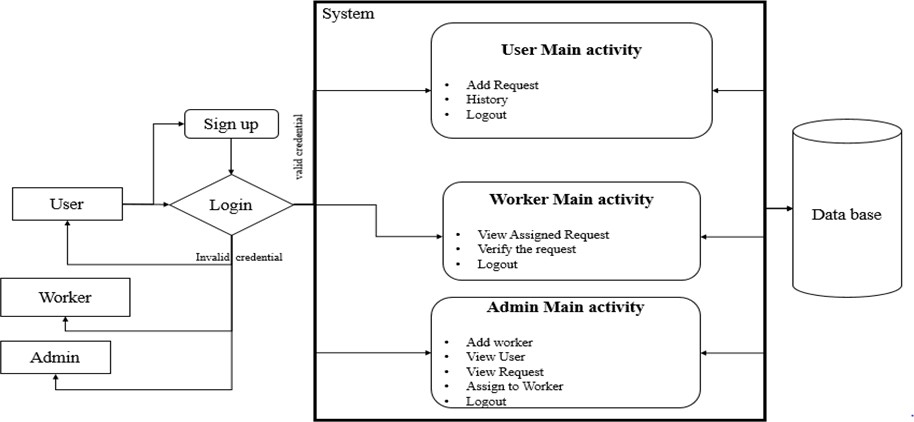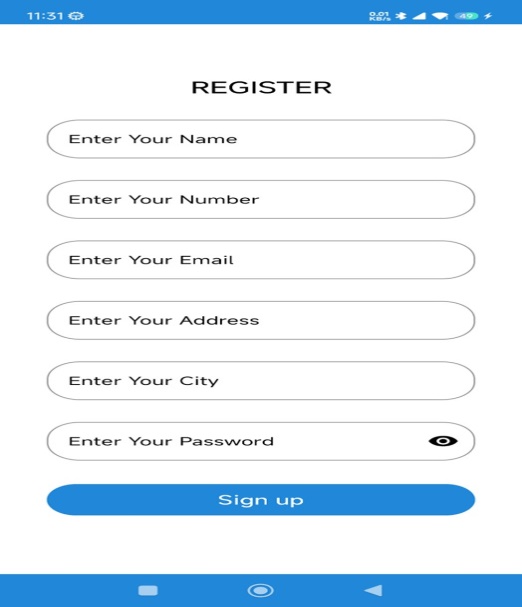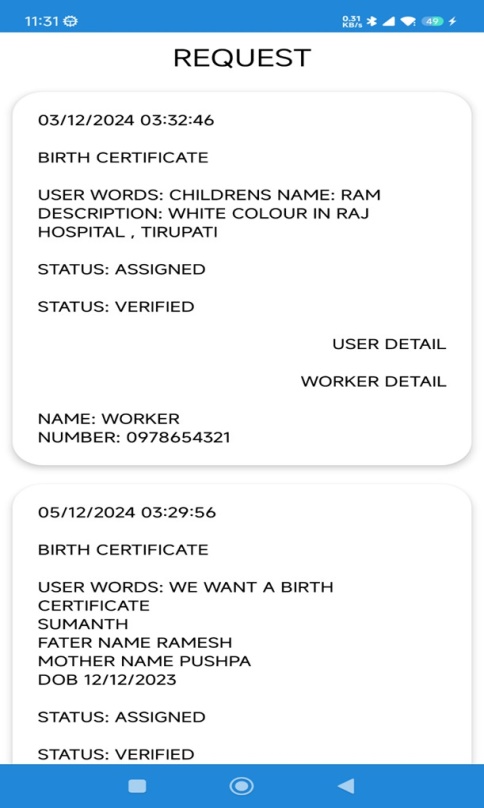Ijraset Journal For Research in Applied Science and Engineering Technology
- Home / Ijraset
- On This Page
- Abstract
- Introduction
- Conclusion
- References
- Copyright
Birth/Death Registration Integration with Services
Authors: Sumanth R, Nithin Gowda M, Girish G R, Dr. Kuppala Saritha
DOI Link: https://doi.org/10.22214/ijraset.2025.66435
Certificate: View Certificate
Abstract
The “Birth/Death Registration Integration with Ser- vices” Android application is designed to modernize and stream- line the process of registering and managing birth and death certificates. This system features three distinct user roles: Admins, Users, and Workers. Admins oversee request management, assign tasks, and upload finalized certificates. Users can register, submit requests for certificates, and track their application statuses, while Workers are responsible for verifying requests and updating their progress in real-time. By digitizing these processes, the system reduces administrative burden, enhances transparency, and improves service accessibility. The project employs a secure, centralized architecture to address inefficiencies in traditional methods, ensuring robust and reliable service delivery.
Introduction
I. INTRODUCTION
This The traditional process of registering births and deaths is often cumbersome, time-consuming, and prone to errors. Citizens are required to visit government offices, fill out extensive paperwork, and wait for prolonged periods to receive certificates. This inefficiency frustrates citizens and overburdens administrative staff, leading to delays and lack of transparency in service delivery. The absence of real-time updates further exacerbates these challenges, making it difficult for stakeholders to track the progress of requests.
To address these issues, the “Birth/Death Registration Integration with Services” application provides a comprehensive digital solution. By integrating real-time updates, automated workflows, and secure data management, this application aims to revolutionize the way vital records are handled. It eliminates the need for manual processes, offering a user- friendly interface that simplifies interactions for all stakeholders. This system supports three primary roles—Admin, User, and Worker—ensuring that each participant in the process has access to role-specific functionalities.
The objective is to enhance the efficiency, transparency, and accessibility of vital record management. Future enhancements could include multilingual support to cater to diverse user groups and mobile app integration for greater convenience. The system could also be extended to allow integration with e-Government services, providing citizens with a unified plat- form for managing multiple records. Furthermore, incorporating advanced analytics could enable authorities to identify trends and improve resource allocation, ultimately streamlining public administration. These advancements ensure that the application evolves as a robust and adaptable tool for modernizing civil registration processes.
II. LITERATURE SURVEY
A thorough review of existing literature highlights the growing importance of e-governance in civil registration services. Bhattacharya and Saha (2020) discuss the shift from manual to digital systems, emphasizing the role of mobile applications in enhancing service delivery. They identify the primary challenges in manual systems, such as delays, inaccuracies, and lack of accessibility, and highlight how digital platforms address these issues [1].
Gupta and Sharma (2021) explore the potential of mobile- based solutions for government certificate issuance. Their research underscores the importance of real-time updates and user-friendly interfaces in improving efficiency and reducing processing times. However, they also point out challenges like security concerns and the digital divide [2].
Kumar and Singh (2020) present a case study on the successful implementation of a digital birth and death registration system in a developing country. The study showcases how digital systems improve accuracy, reduce delays, and streamline administrative tasks. It also highlights the need for robust database management and user-centric designs [3].
Reddy and Rao (2019) examine the features of mobile applications for civil registration, focusing on functionalities like online registration, document tracking, and instant notifications. Their findings indicate that such features significantly enhance user satisfaction and streamline workflows [4].
Mishra and Patil (2022) delve into the concept of smart government systems, emphasizing the integration of mobile technology for managing vital records. They stress the importance of secure data handling, scalability, and seamless integration with existing infrastructure. These studies collectively highlight the gaps in traditional systems and the potential of digital platforms to address these challenges effectively [5].
III. PROPOSED METHODOLOGY
A. Existing System
The traditional system for registering births and deaths is largely manual, involving physical paperwork and in- person visits to government offices. These processes are time- consuming and prone to human errors, leading to inefficiencies and delays. Citizens often face challenges in tracking their requests, and administrative staff struggle to manage large volumes of paperwork. The lack of real-time updates further complicates the process, resulting in poor service delivery.
B. Proposed System
The proposed system introduces a digital platform to address the inefficiencies of the traditional system. This Android based application integrates three primary user roles:
- Admins: Responsible for managing user requests, as- signing tasks to workers, and uploading finalized certificates
- Users: Citizens who can register, submit requests for birth or death certificates, and track their application statuses.
- Workers: Staff members who verify requests and update their progress in real-time.
The application employs a centralized architecture that ensures data integrity and security. Real-time notifications keep stakeholders informed at every stage of the process, while the role-based access system ensures that each user has access only to the functionalities relevant to their role. The system is designed to be user-friendly and accessible, ensuring seamless interaction for all participants.
C. System Architecture
The architecture of the “Birth/Death Registration Integration with Services” system as shown in the Fig. 1 is designed to be modular and scalable, ensuring efficient operation and easy future enhancements. It comprises the following components:
- Frontend: The user interface is implemented as an Android-based mobile application, ensuring accessibility for a broad user base. The app’s design prioritizes user-friendliness, incorporating intuitive navigation for all roles (Admin, User, Worker).
- Backend: The backend architecture is built on MySQL for database management, ensuring reliable and efficient data storage and retrieval. PHP is used for server-side scripting, enabling robust interactions between the application and the database.
- Real-Time Notifications: Notifications are implemented to keep all stakeholders informed. Using push notification services integrated into the Android framework, the app de- livers real-time updates about the status of requests, task assignments, and approvals.
- System Workflow: Authentication Layer: Ensures secure login for Admins, Users, and Workers.
- Role-Based Dashboard: Provides tailored interfaces depending on the logged-in user’s role.
- Task Management: Admins can assign tasks to Workers. Workers can view their tasks and update statuses.
- Request Tracking: Users can track their requests and receive updates.
- Data Management: A centralized database securely stores and retrieves data related to birth and death registrations, ensuring data integrity.
5. Diagrams
- Class Diagram: Displays the relationships between classes such as User, Admin, Worker, Request, and Certificate. Each class encapsulates attributes and methods relevant to the operations they perform.
- Use Case Diagram: Highlights user interactions with the system. For example, Users can register and request certificates, Admins can manage tasks, and Workers can verify requests.
- Sequence Diagram: Details the sequence of operations during a typical workflow, such as a User requesting a certificate and a Worker processing it.
- Activity Diagram: Depicts workflows like certificate issuance, showing decision points, loops, and outcomes.
- Deployment Diagram: Maps software components to physical nodes, showing the deployment of backend services on cloud servers and the frontend on Android devices.

Fig. 1. Architecture of the proposed system
IV. SYSTEM DESIGN AND IMPLEMENTATION
The system’s design emphasizes scalability, security, and ease of use, ensuring a reliable platform that caters to the diverse needs of its users. It is structured to support seamless operations, robust performance, and future scalability. The functional requirements are tailored to user-specific roles: Ad- mins manage worker accounts, requests, and task assignments; Users register on the platform, submit certificate requests, and track their statuses in real-time; and Workers verify requests and update the system dynamically to ensure accurate, up-to- date information. These operations are supported by a centralized database architecture, which guarantees data consistency and security by minimizing conflicts and unauthorized access.
Non-functional requirements focus on maintaining high performance, supporting future scalability, and implementing robust encryption protocols to protect sensitive data. The architecture adopts a client-server model that integrates mobile front-end applications with a backend database, facilitating efficient data communication between various components.
Unified Modeling Language (UML) diagrams provide a blueprint for the system’s design and operation. The Activity Diagram outlines workflows for critical processes such as request registration and status verification, while the Class Diagram defines relationships among objects, ensuring efficient data handling and communication across modules. Together, these tools serve as a roadmap for the system’s development and maintenance. The system’s functionality relies on specific hardware and software components, as outlined in Table I. The hardware requirements include an Intel i3 processor, 8GB RAM, and a 1TB hard disk to ensure optimal performance. On the software side, essential tools like the Android SDK, Android Studio, and MySQL database are used, alongside JDK for Java and Kotlin plugins, to ensure compatibility with modern development practices. This combination of hardware and soft- ware establishes a robust foundation for system development, deployment, and maintenance, supporting its ability to meet diverse user needs effectively.
TABLE I
Required Components
|
|
Component Type |
|
|
Sl. No |
Hardware |
Software |
|
1. |
Processor- I3/Intel Processor |
Operating System-Win 10 |
|
2. |
RAM-8GB |
JDK-java |
|
3. |
Hard Disk-1TB |
Plugin-Kotlin |
|
4. |
- |
SDK-Android |
|
5. |
- |
IDE-Android studio |
|
6. |
- |
Database-MY SQL, PHP |
V. RESULTS AND DISCUSSION
The application was tested extensively across multiple scenarios to validate its functionality, security, and usability. The testing phase involved comprehensive unit, integration, and system-level tests, ensuring that each component operated as intended within the larger system.
A. Testing Methodology
- Unit Testing: Focuses on individual modules to ensure they function correctly. For example, the login functionality was tested to handle both valid and invalid inputs.
- Integration Testing: Validates the interaction between modules. For instance, the linkage between the Admin module and Worker module for task assignment was tested.
- System Testing: Ensures the entire system works seamlessly. The end-to-end workflow, from User request submission to certificate issuance, was tested.
- Acceptance Testing: Conducted with a sample group of end users to validate the application’s usability and functionality.
- Black Box Testing: Testers provided inputs and observed outputs without knowledge of internal workings. For example, submitting a certificate request tested for proper handling and response.
- White Box Testing: Focused on code-level testing to verify logical paths and data flows.
- Performance Testing: Evaluated the system’s response time under different loads to ensure it meets expected performance levels.
The Table II shows the test cases conducted.
The test case table summarizes the validation of core functionalities for the “Birth/Death Registration Integration with Services” system. It outlines four key scenarios tested to ensure seamless operation. The Successful Signup scenario confirms that user data is accurately stored in the database, while the Successful Login validates the system’s ability to authenticate users. The Task Assignment scenario ensures that tasks assigned by the Admin are successfully displayed on the Worker’s dashboard. Lastly, the Realtime Notification test verifies the timely delivery of notifications to users. All test cases have passed successfully, demonstrating the system’s robustness, reliability, and effectiveness in handling essential workflows.
With the test cases results Fig. 2 depicts the user registration page where the user registers him/her self on the application and provide necessary details to get the certificate. Similarly, the Fig. 3 shows the admin task assigning page where admin gets the notification from the registered users and assign those works to the workers to complete the requested documents.
In conclusion, the system effectively supports both user registration and administrative tasks, ensuring a seamless flow of operations. The user registration page simplifies the process of providing necessary details for generating certificates, while the admin task assigning page streamlines the allocation of work based on user requests. The ability to download certificates online with real-time notifications enhances convenience and ensures timely access to completed documents. Overall, these features contribute to a more efficient and user-friendly application experience.

Fig. 2. User registration page
TABLE II
Test case table
|
Test Case ID |
|
Test Cases |
|
|
|
Scenario |
Expected Outcome |
Status |
|
CVD001 |
Successful Signup |
Data stored in the database |
Pass |
|
CVD002 |
Successful Login |
Authentication Successful |
Pass |
|
CVD003 |
Task Assignment |
Worker gets tasks |
Pass |
|
CVD004 |
Realtime Notification |
Notification delivered |
Pass |

Fig. 3. Admin task assigning page
Conclusion
The “Birth/Death Registration Integration with Services” application represents a transformative approach to managing civil registration. By automating manual processes, the system reduces errors, accelerates service delivery, and enhances transparency for all stakeholders. Its centralized architecture ensures consistent data management and secure handling of sensitive information, benefiting both citizens and administrative bodies. Furthermore, the user-friendly design simplifies workflows, making the application accessible to a wide range of users. Future iterations of the system could integrate biometric authentication for enhanced security and expand functionalities to include additional vital records, such as marriage and adoption certificates. Developing a web-based interface would further improve accessibility, enabling multi-platform support and ensuring the system’s adaptability to evolving techno- logical trends. Additionally, real-time notifications could be incorporated to update users on the status of their requests, im- proving overall service satisfaction. Integration with national identity databases would streamline verification processes, reducing redundancy. These enhancements will solidify the application’s role in revolutionizing civil registration processes and setting a benchmark for modern administrative systems.
References
[1] Bhattacharya, P.,and Saha, S. (2020). E-Government Systems: A Review of Digital Transformation in Civil Registration Services. International Journal of Computer Science and Information Technology, 11(2), 135- 142. [2] Gupta, R., and Sharma, P. (2021). A Mobile App-Based Approach to Simplifying Government Certificate Issuance: Challenges and Opportunities. Journal of Digital Government, 16(4), 37-45. [3] Kumar, V., and Singh, S. (2020). Digital Birth and Death Registration System for Efficient Government Services. International Journal of Public Administration, 33(1), 88-102. [4] Reddy, K., and Rao, M. (2019). Leveraging Mobile Applications for Streamlining Civil Registration Processes. International Journal of Computer Applications, 183(5), 51 58. [5] Mishra, N., and Patil, A. (2022). Smart Government Systems: Mobile Solutions for Efficient Civil Services Delivery. IEEE Access, 10, 11689- 11698. [6] Thomas, D., and Rodriguez, J. (2020). Cloud-Based E-Government Solutions for Record Management. Government Information Quarterly, 37(3), 438-446. [7] Singh, A., and Mehta, S. (2019). Improvement of Public Service Delivery through Mobile Applications in India. Journal of e-Government Studies, 7(4), 112-124. [8] Patel, R., and Desai, A. (2021). Implementation of Birth and Death Registration System using Mobile Technology. Journal of Government Information Management, 29(2), 55-63. [9] Soni, R., and Gupta, P. (2021). Blockchain and Mobile Technologies for Secure Civil Registration Systems. Journal of Digital Security and Privacy, 14(6), 21-30. [10] Chand, R., and Yadav, M. (2020). Digital Transformation in Public Ser- vices: A Case Study of Certificate Management Systems. International Journal of Administrative Science, 12(3), 98-107.
Copyright
Copyright © 2025 Sumanth R, Nithin Gowda M, Girish G R, Dr. Kuppala Saritha. This is an open access article distributed under the Creative Commons Attribution License, which permits unrestricted use, distribution, and reproduction in any medium, provided the original work is properly cited.

Download Paper
Paper Id : IJRASET66435
Publish Date : 2025-01-09
ISSN : 2321-9653
Publisher Name : IJRASET
DOI Link : Click Here
 Submit Paper Online
Submit Paper Online

